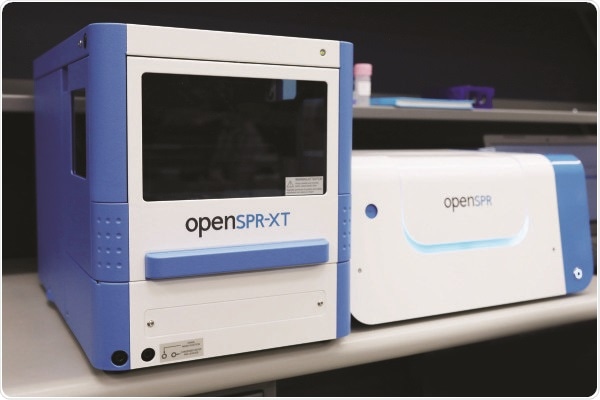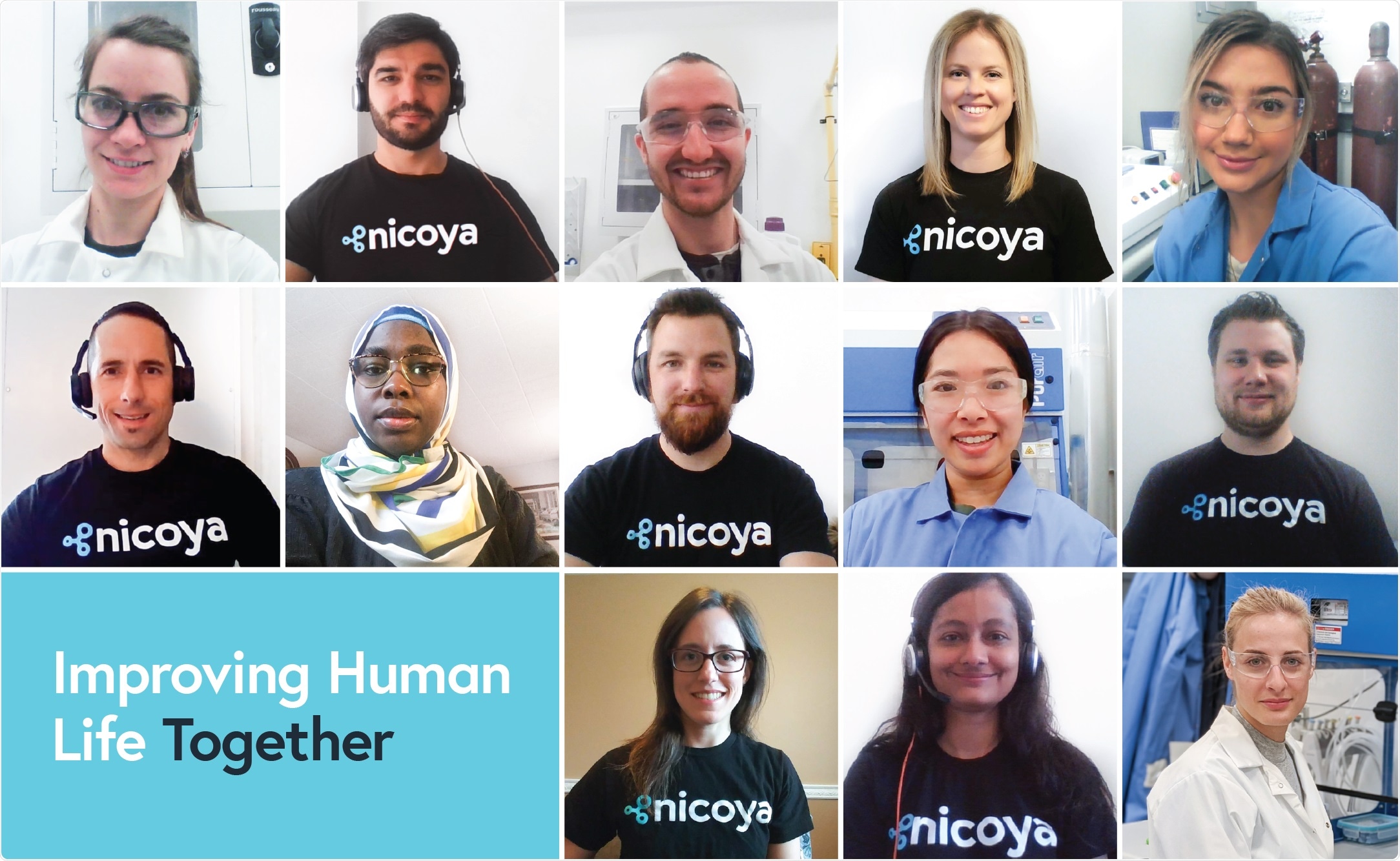Ryan Denomme, the CEO of Nicoya, speaks to News-Medical on their SARS-CoV-2 research using their SPR technology.
Why did Nicoya choose to research the SARS-CoV-2 virus?
At Nicoya, our mission is to improve human life by helping scientists succeed. Given the current circumstances of the global pandemic, the best way for us to continue this mission is by supporting front-line researchers who are working tirelessly to find solutions for the virus.
Given the relevance of our instruments to viral research, we were very happy to be able to help with this incredibly important cause.
What is Surface Plasmon Resonance (SPR) and why is it useful in examining the SARS-CoV-2 virus?
SPR is a gold-standard technique for characterizing the binding affinity (Kd) and kinetics (Kon/Koff) of biomolecular interactions. This means that our SPR instruments can give researchers insight into how two molecules are interacting in real-time.
This is incredibly important when examining SARS-CoV-2 because it can allow researchers to better understand how the virus is interacting with cells and receptors in the human body.
Through a series of direct interactions with proteins on the cell surface, the SARS-CoV-2 virus is able to target cells of the respiratory tract and take advantage of the cellular machinery.
The first step in this process is the targeting of cells that is mediated through direct binding of the viral spike (S) protein to a cell surface protein, in this case, Angiotensin-Converting Enzyme 2 (ACE-2).
This protein-protein interaction is critical for viral attachment and it is followed by a key processing step. The SARS-CoV-2 virus is able to take advantage of a cell-surface enzyme, Transmembrane protease serine 2 (TMPRSS2), to cleave the S protein, enabling the fusion of the viral and cellular membranes and subsequent infection.
Elucidating regulation and kinetics of these two novel interactions is critical to understanding the SARS-CoV-2 mode of entry into cells and designing effective therapies for COVID-19.
.jpg)
Image Credit: Kateryna Kon/Shutterstock.com
Why is it important to gather binding data on the SARS-CoV-2 virus?
Binding data is important because it allows researchers to understand where the virus is exerting its effects. If you can look at the strength and time-course of interaction, you can get a better understanding of where in the body the virus is targeting.
This allows scientists to better target the virus with preventative strategies to help mitigate the health effects and produce the most reliable testing kits and vaccines.
In particular, therapeutic efforts focusing on blocking of viral entry are using binding data to study the effects of various inhibitors on the interaction between the viral S protein and its cellular target ACE-2.
Modulation of this binding, as well as the targeting of S protein processing by the TMPRSS2 enzyme, is currently driving efforts around the world in repurposing some of the existing drugs and screening for novel inhibitors of these interactions.
Also, this is a novel virus and is behaving differently from previously known coronaviruses, so we can use binding data to help elucidate why that might be.
What benefits does OpenSPR-XT have compared to other analytical techniques?
SPR gives you binding affinity and kinetics data in real-time without the use of labels. This is beneficial because it is common for other analytical techniques such as Co-Immunoprecipitation assays (CoIPs), or Isothermal Titration Calorimetry (ITC) to give yes/no binding data or just the affinity of the interaction without telling the whole story, and sometimes these techniques lack sensitivity.
These assays can often be frustrating with data not given until the end, which makes troubleshooting more difficult and wastes precious time in the face of a pandemic. The ability to have real-time data allows researchers to more quickly reach important conclusions and iterate.
OpenSPR also provides a high degree of sensitivity which allows a comprehensive range of biomolecular interactions to be analyzed with confidence that you are minimizing false positives/negatives.
We have designed our instrumentation with the scientist at top of mind. We wanted to make an SPR system that was accessible both from a cost perspective and from an expertise perspective. Because of some innovations that we made to traditional SPR, we were able to do both of these things and get SPR access to more researchers who need it, which helps expedite research in critical times of need.

You carried out a kinetic analysis of the SARS-CoV-2 antibody with the spike protein. How did you do this and what did your results show?
This analysis was performed using our OpenSPR-XT instrument by immobilizing the SARS-CoV-2 S Protein Receptor Binding Domain (RBD) to our SPR chip within the instrument using a standard amine coupling procedure and flowing a SARS-CoV-2 monoclonal antibody over the immobilized RBD.
One of these tests was done with purified antibodies and a second test was performed with antibodies diluted in serum. The kinetics and affinity of the interaction was determined in both conditions, and the specificity of the data was confirmed by using human Immunoglobulin G (IgG) as a negative control.
This data shows the high affinity and specificity of this antibody. Results from serological and purified samples were similar which shows the ability of the OpenSPR-XT to detect binding and measure kinetics even when the antibodies are diluted in serum, a necessity for applications in testing and diagnostics.
What properties were shown of the SARS-CoV-2 monoclonal antibody by OpenSPR and how can this information be used?
Binding affinity and kinetics were shown as well as the specificity of this antibody for the SARS-CoV-2 receptor binding domain. This information can be used in diagnostic testing and vaccine development because it allows researchers insight into the effectiveness of the antibodies to bind to their targets.
We also showed the high specificity of this antibody, which in diagnostics is important as high specificity drives down false-positive rates.
OpenSPR was able to detect antibodies at picomolar concentrations with a low nanomolar affinity constant, which demonstrates the antibody has fairly high sensitivity. This is also important in diagnostic assays as it reduces the rate of false negatives.
How will this data help prevent the spread of the virus?
This data will help prevent the spread of the virus because of its application to diagnostic tests and vaccine research.
The validation of this antibody demonstrates how SPR can be used to effectively screen antibodies for specificity and sensitivity, so the protocol can be applied to thousands of experiments being conducted by hundreds of scientists, helping to expedite many parallel efforts.
What are the next steps in your research?
We are continuing to change the game when it comes to SPR. In January, we released our newest instrument, Alto - the first-ever SPR instrument to integrate digital microfluidics (DMF), artificial intelligence (AI), and nanotechnology. Alto reduces the time and cost of drug discovery, enabling scientists to better understand and cure human diseases faster.
With Alto, all fluidics are contained within the disposable cartridge, so scientists never have to run another cleaning cycle again. It also allows for a huge reduction in the sample requirements. Alto only requires 2μL of the sample which is incredibly important to help reduce the material waste involved in the tedious process of drug discovery.
Alto is also able to handle crude samples which can help make results more clinically relevant, while also reducing upstream processing time.
We designed Alto™ with user-friendliness and accessibility at top of mind. The software solution features AI-driven automation and cloud-based capabilities which will reduce the time that researchers waste troubleshooting experiments and allow them to monitor experiments from the convenience of their smartphone.
The goal with all of these innovations is to greatly improve efficiency within labs which will allow researchers to have more ground-breaking discoveries, thus improving human life. The future of drug discovery is digital and Alto is very well positioned to lead the way.
How is Nicoya ensuring access to its products and services for customers undertaking vital research?
We are partnering with scientists across Canada and the United States who are working on COVID research. This means partnering on grants, providing in-kind contributions, and working with researchers to make sure that they can have access to our instruments if they need them.
We also have a dedicated team of engineers who are taking appropriate precautions and going into the office every day in order to continue producing instruments that we can ship to researchers who need it.
Along with this, we have very well established remote processes so that researchers can be supported every step of the way, from demonstrations to set-up, to experimental optimization and analysis.

How is Nicoya supporting other researchers regarding the pandemic?
We are providing complementary SPR technical support from our experts to anyone with an SPR instrument, Nicoya, or otherwise, regardless of their research area.
This means we are helping them optimize their experimental conditions, and helping with the analysis of data. This will allow these researchers to spend less time troubleshooting and more time working on a solution.
It is like we are extra members of their lab helping with their research at no extra cost.
Where can readers find more information?
Complimentary SPR Support Now Available to All Researchers during COVID-19
Application Note: Binding of SARS-CoV-2 Antibody to the Spike Protein Receptor Binding Domain using OpenSPR-XT™
Blog Post: Viral Outbreaks – How the Scientific Community Can Find Solutions
Blog Post: Ways to Get Research Funding During COVID-19
What is SPR?
About Nicoya
Nicoya is a leading provider of advanced analytical instruments for the biotechnology and pharmaceutical industries. The Canadian company’s mission is to improve human life by helping scientists succeed.
Its instruments are used by hundreds of world-renowned researchers in over 40 different countries. Information about Nicoya can be found at nicoyalife.com, on Twitter, Facebook, LinkedIn, and Instagram.